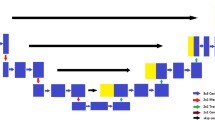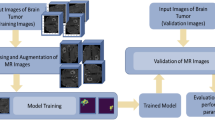Abstract
Glioblastoma is an aggressive type of cancer that can develop in the brain or spinal cord. Magnetic Resonance Imaging (MRI) is key to diagnosing and tracking brain tumors in clinical settings. Brain tumor segmentation in MRI is required for disease diagnosis, surgical planning, and prognosis. As these tumors are heterogeneous in shape and appearance, their segmentation becomes a challenging task. The performance of automated medical image segmentation has considerably improved because of recent advances in deep learning. Introducing context encoding with deep CNN models has shown promise for semantic segmentation of brain tumors. In this work, we use a 3D UNet-Context Encoding (UNCE) deep learning network for improved brain tumor segmentation. Further, we introduce epistemic and aleatoric Uncertainty Quantification (UQ) using Monte Carlo Dropout (MCDO) and Test Time Augmentation (TTA) with the UNCE deep learning model to ascertain confidence in tumor segmentation performance. We build our model using the training MRI image sets of RSNA-ASNR-MICCAI Brain Tumor Segmentation (BraTS) Challenge 2021. We evaluate the model performance using the validation and test images from the BraTS challenge dataset. Online evaluation of validation data shows dice score coefficients (DSC) of 0.7787, 0.8499, and 0.9159 for enhancing tumor (ET), tumor core (TC), and whole tumor (WT), respectively. The dice score coefficients of the test datasets are 0.6684 for ET, 0.7056 for TC, and 0.7551 for WT, respectively.
Access this chapter
Tax calculation will be finalised at checkout
Purchases are for personal use only
Similar content being viewed by others
References
Baid, U., et al.: The RSNA-ASNR-MICCAI BraTS 2021 Benchmark on Brain Tumor Segmentation and Radiogenomic Classification, arXiv:2107.02314 (2021)
Ostrom, Q.T., Gittleman, H., Truitt, G., Boscia, A., Kruchko, C., Barnholtz-Sloan, J.S.: CBTRUS statistical report: primary brain and other central nervous system tumors diagnosed in the United States in 2011–2015. Neurooncology, 20(suppl_4), iv1–iv86 (2018)
Pereira, S., Pinto, A., Alves, V., Silva, C.A.: Brain tumor segmentation using convolutional neural networks in MRI images. IEEE Trans. Med. Imaging 35(5), 1240–1251 (2016)
Pei, L., Vidyaratne, L., Monibor Rahman, M., Shboul, Z.A., Iftekharuddin, K.M.: Multimodal brain tumor segmentation and survival prediction using hybrid machine learning. In: Crimi, A., Bakas, S. (eds.) BrainLes 2019. LNCS, vol. 11993, pp. 73–81. Springer, Cham (2020). https://doi.org/10.1007/978-3-030-46643-5_7
Pei, L., et al.: Deep learning with context encoding for semantic brain tumor segmentation and patient survival prediction. Proceedings Volume 11314, Medical Imaging 2020. Computer-Aided Diagnosis, 113140H (2020). https://doi.org/10.1117/12.2550693
Mustaqeem, A., Javed, A., Fatima, T.: An efficient brain tumor detection algorithm using watershed & thresholding-based segmentation. Int. J. Image Graph. Signal Process. 4(10), 34 (2012)
Pei, L., Vidyaratne, L., Hsu, W.W., Rahman, M.M., Iftekharuddin, K.M.: Brain tumor classification using 3D convolutional neural network. Brainlesion: Glioma, Multiple Sclerosis, Stroke and Traumatic Brain Injuries, pp. 335–342, May 2020
Prastawa, M., Bullitt, E., Ho, S., Gerig, G.: A brain tumor segmentation framework based on outlier detection. Med. Image Anal. 8(3), 275–283 (2004)
Ho, S., Bullitt, E., Gerig, G.: Level-set evolution with region competition: automatic 3-D segmentation of brain tumors. In: null, p. 10532. Citeseer (2002)
Myronenko, A.: 3D MRI brain tumor segmentation using autoencoder regularization. In: International MICCAI Brainlesion Workshop, pp. 311–320. Springer (2018)
Pei, L., Vidyaratne, L., Rahman, M.M., et al.: Context aware deep learning for brain tumor segmentation, subtype classification, and survival prediction using radiology images. Sci. Rep. 10, 19726 (2020). https://doi.org/10.1038/s41598-020-74419-9
Kingma, D.P., Ba, J.: Adam: a method for stochastic optimization, arXiv preprint arXiv:1412.6980 (2014)
Zhang, H., et al.: Context encoding for semantic segmentation. In: Proceedings of the IEEE Conference on Computer Vision and Pattern Recognition, pp. 7151–7160 (2018)
Wang, G., Li, W., Aertsen, M., Deprest, J., Ourselin, S´., Vercauteren, T.: Aleatoric uncertainty estimation with test-time augmentation for medical image segmentation with convolutional neural networks. Neurocomputing, 338, 34–45 (2019)
Menze, B.H., Jakab, A., Bauer, S., Kalpathy-Cramer, J., Farahani, K., Kirby, J., et al.: The multimodal brain tumor image segmentation benchmark (BRATS). IEEE Trans. Med. Imaging 34(10), 1993–2024 (2015). https://doi.org/10.1109/TMI.2014.2377694
Bakas, S., Akbari, H., Sotiras, A., Bilello, M., Rozycki, M., Kirby, J.S., et al.: Advancing the cancer genome atlas glioma MRI collections with expert segmentation labels and radiomic features. Nat. Sci. Data 4, 170117 (2017). https://doi.org/10.1038/sdata.2017.117
Bakas, S., et al.: Segmentation labels and radiomic features for the pre-operative Scans of the TCGA-GBM collection. The Cancer Imaging Archive (2017). https://doi.org/10.7937/K9/TCIA.2017.KLXWJJ1Q
Bakas, S., et al.: Segmentation labels and radiomic features for the pre-operative scans of the TCGA-LGG collection. The Cancer Imaging Archive (2017). https://doi.org/10.7937/K9/TCIA.2017.GJQ7R0EF
Liu, D., et al.: Imaging-genomics in glioblastoma: combining molecular and imaging signatures. Front. Oncol. 11, 2666 (2021). https://www.frontiersin.org/article/10.3389/fonc.2021.699265
Dice, L.R.: Measures of the amount of ecologic association between species. Ecology 26(3), 297–302 (1945)
Ronneberger, O., Fischer, P., Brox, T.: U-Net: convolutional networks for biomedical image segmentation. In: Navab, N., Hornegger, J., Wells, W., Frangi, A. (eds.) MICCAI 2015. LNIP, vol. 9351, pp. 234–241. Springer, Cham (2015). https://doi.org/10.1007/978-3-319-24574-4_28
Gal, Y., et al.: Dropout as a Bayesian approximation: representing model uncertainty in deep learning. In: Proceedings of the 33rd International Conference on Machine Learning, New York, NY, USA (2016)
Combalia, M., Hueto, F., Puig, S., Malvehy, J., Vilaplana, V.: Uncertainty estimation in deep neural networks for dermoscopic image classification. In: 2020 IEEE/CVF Conference on Computer Vision and Pattern Recognition Workshops (CVPRW), pp. 3211-3220 (2020). https://doi.org/10.1109/CVPRW50498.2020.00380
Acknowledgements
This work was partially funded through NIH/NIBIB grant under award number R01EB020683. This research was supported by the Research Computing clusters at Old Dominion University, Norfolk, VA under National Science Foundation Grant No. 1828593.
Author information
Authors and Affiliations
Corresponding author
Editor information
Editors and Affiliations
Rights and permissions
Copyright information
© 2022 The Author(s), under exclusive license to Springer Nature Switzerland AG
About this paper
Cite this paper
Rahman, M.M., Sadique, M.S., Temtam, A.G., Farzana, W., Vidyaratne, L., Iftekharuddin, K.M. (2022). Brain Tumor Segmentation Using UNet-Context Encoding Network. In: Crimi, A., Bakas, S. (eds) Brainlesion: Glioma, Multiple Sclerosis, Stroke and Traumatic Brain Injuries. BrainLes 2021. Lecture Notes in Computer Science, vol 12962. Springer, Cham. https://doi.org/10.1007/978-3-031-08999-2_40
Download citation
DOI: https://doi.org/10.1007/978-3-031-08999-2_40
Published:
Publisher Name: Springer, Cham
Print ISBN: 978-3-031-08998-5
Online ISBN: 978-3-031-08999-2
eBook Packages: Computer ScienceComputer Science (R0)





